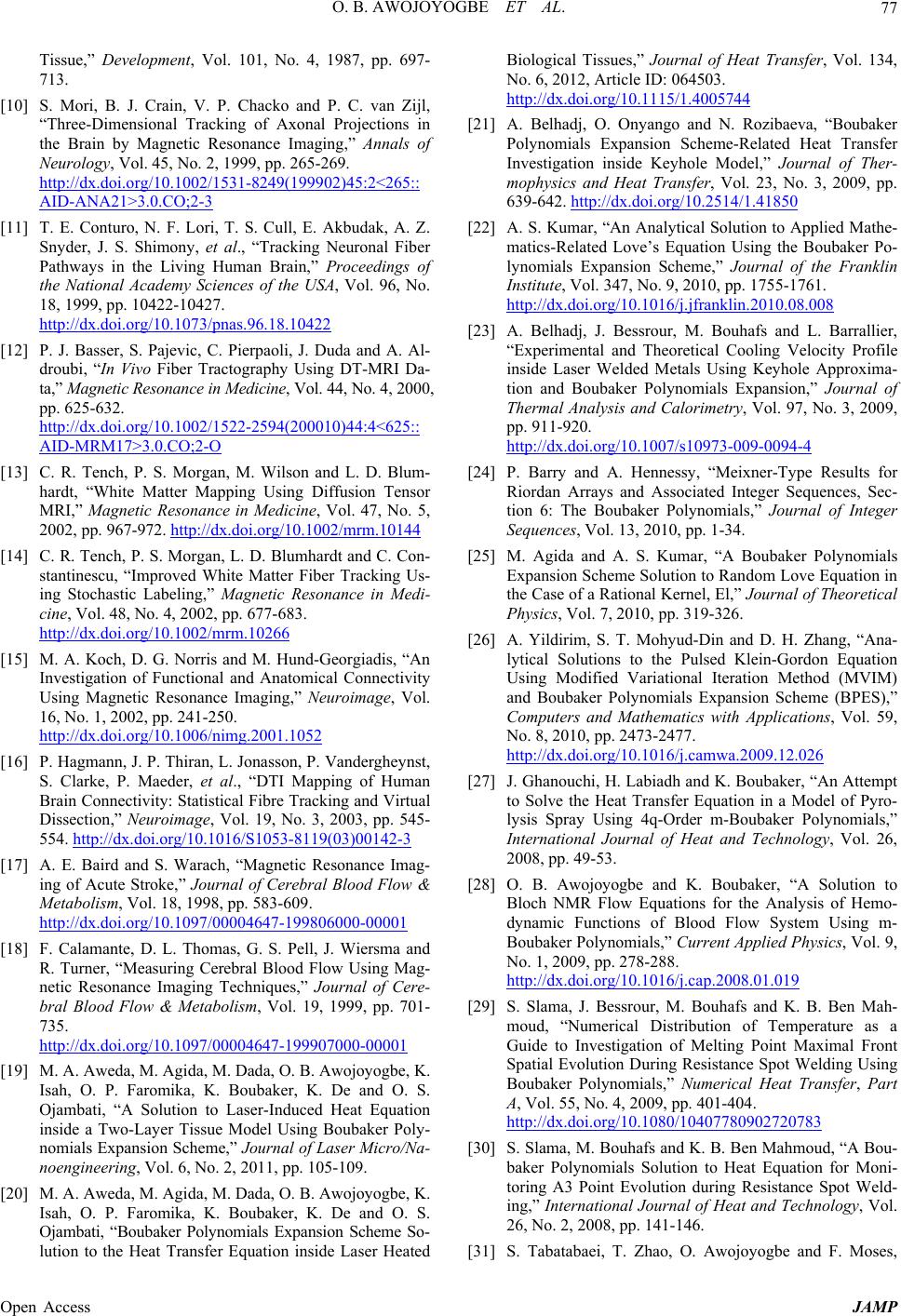
O. B. AWOJOYOGBE ET AL. 77
Tissue,” Development, Vol. 101, No. 4, 1987, pp. 697-
713.
[10] S. Mori, B. J. Crain, V. P. Chacko and P. C. van Zijl,
“Three-Dimensional Tracking of Axonal Projections in
the Brain by Magnetic Resonance Imaging,” Annals of
Neurology, Vol. 45, No. 2, 1999, pp. 265-269.
http://dx.doi.org/10.1002/1531-8249(199902)45:2<265::
AID-ANA21>3.0.CO;2-3
[11] T. E. Conturo, N. F. Lori, T. S. Cull, E. Akbudak, A. Z.
Snyder, J. S. Shimony, et al., “Tracking Neuronal Fiber
Pathways in the Living Human Brain,” Proceedings of
the National Academy Sciences of the USA, Vol. 96, No.
18, 1999, pp. 10422-10427.
http://dx.doi.org/10.1073/pnas.96.18.10422
[12] P. J. Basser, S. Pajevic, C. Pierpaoli, J. Duda and A. Al-
droubi, “In Vivo Fiber Tractography Using DT-MRI Da-
ta,” Magnetic Resonance in Medicine, Vol. 44, No. 4, 2000,
pp. 625-632.
http://dx.doi.org/10.1002/1522-2594(200010)44:4<625::
AID-MRM17>3.0.CO;2-O
[13] C. R. Tench, P. S. Morgan, M. Wilson and L. D. Blum-
hardt, “White Matter Mapping Using Diffusion Tensor
MRI,” Magnetic Resonance in Medicine, Vol. 47, No. 5,
2002, pp. 967-972. http://dx.doi.org/10.1002/mrm.10144
[14] C. R. Tench, P. S. Morgan, L. D. Blumhardt and C. Con-
stantinescu, “Improved White Matter Fiber Tracking Us-
ing Stochastic Labeling,” Magnetic Resonance in Medi-
cine, Vol. 48, No. 4, 2002, pp. 677-683.
http://dx.doi.org/10.1002/mrm.10266
[15] M. A. Koch, D. G. Norris and M. Hund-Georgiadis, “An
Investigation of Functional and Anatomical Connectivity
Using Magnetic Resonance Imaging,” Neuroimage, Vol.
16, No. 1, 2002, pp. 241-250.
http://dx.doi.org/10.1006/nimg.2001.1052
[16] P. Hagmann, J. P. Thiran, L. Jonasson, P. Vandergheynst,
S. Clarke, P. Maeder, et al., “DTI Mapping of Human
Brain Connectivity: Statistical Fibre Tracking and Virtual
Dissection,” Neuroimage, Vol. 19, No. 3, 2003, pp. 545-
554. http://dx.doi.org/10.1016/S1053-8119(03)00142-3
[17] A. E. Baird and S. Warach, “Magnetic Resonance Imag-
ing of Acute Stroke,” Journal of Cerebral Blood Flow &
Metabolism, Vol. 18, 1998, pp. 583-609.
http://dx.doi.org/10.1097/00004647-199806000-00001
[18] F. Calamante, D. L. Thomas, G. S. Pell, J. Wiersma and
R. Turner, “Measuring Cerebral Blood Flow Using Mag-
netic Resonance Imaging Techniques,” Journal of Cere-
bral Blood Flow & Metabolism, Vol. 19, 1999, pp. 701-
735.
http://dx.doi.org/10.1097/00004647-199907000-00001
[19] M. A. Aweda, M. Agida, M. Dada, O. B. Awojoyogbe, K.
Isah, O. P. Faromika, K. Boubaker, K. De and O. S.
Ojambati, “A Solution to Laser-Induced Heat Equation
inside a Two-Layer Tissue Model Using Boubaker Poly-
nomials Expansion Scheme,” Journal of Laser Micro/Na-
noengineering, Vol. 6, No. 2, 2011, pp. 105-109.
[20] M. A. Aweda, M. Agida, M. Dada, O. B. Awojoyogbe, K.
Isah, O. P. Faromika, K. Boubaker, K. De and O. S.
Ojambati, “Boubaker Polynomials Expansion Scheme So-
lution to the Heat Transfer Equation inside Laser Heated
Biological Tissues,” Journal of Heat Transfer, Vol. 134,
No. 6, 2012, Article ID: 064503.
http://dx.doi.org/10.1115/1.4005744
[21] A. Belhadj, O. Onyango and N. Rozibaeva, “Boubaker
Polynomials Expansion Scheme-Related Heat Transfer
Investigation inside Keyhole Model,” Journal of Ther-
mophysics and Heat Transfer, Vol. 23, No. 3, 2009, pp.
639-642. http://dx.doi.org/10.2514/1.41850
[22] A. S. Kumar, “An Analytical Solution to Applied Mathe-
matics-Related Love’s Equation Using the Boubaker Po-
lynomials Expansion Scheme,” Journal of the Franklin
Institute, Vol. 347, No. 9, 2010, pp. 1755-1761.
http://dx.doi.org/10.1016/j.jfranklin.2010.08.008
[23] A. Belhadj, J. Bessrour, M. Bouhafs and L. Barrallier,
“Experimental and Theoretical Cooling Velocity Profile
inside Laser Welded Metals Using Keyhole Approxima-
tion and Boubaker Polynomials Expansion,” Journal of
Thermal Analysis and Calorimetry, Vol. 97, No. 3, 2009,
pp. 911-920.
http://dx.doi.org/10.1007/s10973-009-0094-4
[24] P. Barry and A. Hennessy, “Meixner-Type Results for
Riordan Arrays and Associated Integer Sequences, Sec-
tion 6: The Boubaker Polynomials,” Journal of Integer
Sequences, Vol. 13, 2010, pp. 1-34.
[25] M. Agida and A. S. Kumar, “A Boubaker Polynomials
Expansion Scheme Solution to Random Love Equation in
the Case of a Rational Kernel, El,” Journal of Theoretical
Physics, Vol. 7, 2010, pp. 319-326.
[26] A. Yildirim, S. T. Mohyud-Din and D. H. Zhang, “Ana-
lytical Solutions to the Pulsed Klein-Gordon Equation
Using Modified Variational Iteration Method (MVIM)
and Boubaker Polynomials Expansion Scheme (BPES),”
Computers and Mathematics with Applications, Vol. 59,
No. 8, 2010, pp. 2473-2477.
http://dx.doi.org/10.1016/j.camwa.2009.12.026
[27] J. Ghanouchi, H. Labiadh and K. Boubaker, “An Attempt
to Solve the Heat Transfer Equation in a Model of Pyro-
lysis Spray Using 4q-Order m-Boubaker Polynomials,”
International Journal of Heat and Technology, Vol. 26,
2008, pp. 49-53.
[28] O. B. Awojoyogbe and K. Boubaker, “A Solution to
Bloch NMR Flow Equations for the Analysis of Hemo-
dynamic Functions of Blood Flow System Using m-
Boubaker Polynomials,” Current Applied Physics, Vol. 9,
No. 1, 2009, pp. 278-288.
http://dx.doi.org/10.1016/j.cap.2008.01.019
[29] S. Slama, J. Bessrour, M. Bouhafs and K. B. Ben Mah-
moud, “Numerical Distribution of Temperature as a
Guide to Investigation of Melting Point Maximal Front
Spatial Evolution During Resistance Spot Welding Using
Boubaker Polynomials,” Numerical Heat Transfer, Part
A, Vol. 55, No. 4, 2009, pp. 401-404.
http://dx.doi.org/10.1080/10407780902720783
[30] S. Slama, M. Bouhafs and K. B. Ben Mahmoud, “A Bou-
baker Polynomials Solution to Heat Equation for Moni-
toring A3 Point Evolution during Resistance Spot Weld-
ing,” International Journal of Heat and Technology, Vol.
26, No. 2, 2008, pp. 141-146.
[31] S. Tabatabaei, T. Zhao, O. Awojoyogbe and F. Moses,
Open Access JAMP